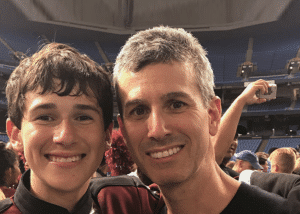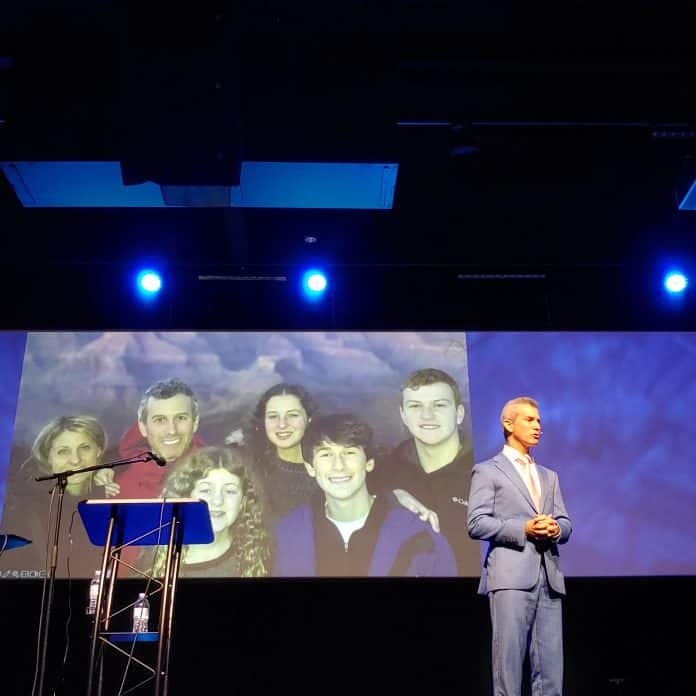Max Schachter never expected his fourteen-year-old son to become a victim of a school mass shooting. Nor did he expect to devote his life to campaigning for an end to school violence and for safer schools. But this is the position in which the father of four found himself five years ago.
February 14, 2018, the news was filled with yet another mass shooting at a school. This time it was at Marjorie Stoneman Douglas High School in Broward County, Florida. In a space of just three minutes and fifty-one seconds, Nikolas Cruz shot thirty-four people in Building 12 of the sprawling campus. Seventeen died, including three staff members. Schachter’s son, Alex, was one of the students who died that day.
On Monday, June 5th, Schachter spoke at a workshop on school safety aimed at school and law enforcement personnel. In the four-hour-long presentation, he covered many topics. He spoke about his family and those of the other victims and how the tragedy affected them. Among other issues, he talked about the shooter−his history of behavioral problems and violence and the missed signals that something like this not just could happen but would happen. And perhaps most tragic and preventable was the lack of preparation and training for an incident like this and the mistakes made by school officials and law enforcement during the time the killer entered the campus until he was caught an hour later. Several times in his presentation, Schachter referred to Alex as “my little boy”− a fact that made his talk even more poignant.
In this article and others, I will highlight aspects of Schachter’s presentation− what led up to the shooting and the shooting itself; the immediate aftermath and the crusade that Schachter launched since the tragedy; and the portion of Schachter’s presentation that focused on a wider definition of school safety, including bullying, sexual predators in the schools, and other issues.
Alex’s death was not the first time that Schachter had been hit by tragedy. When Alex was only four years old, his mother passed away suddenly at the age of thirty-six. Schachter was left with two little boys, Ryan and Alex, to take care of. A few years later, he met a widow named Caryn, who had two girls, and they married.
After the shooting, Schachter gave up his insurance business and devoted full time to his campaign. “Nothing else mattered in my life. I wanted to do everything I could to prevent the next tragedy,” he remarked.
His first step was to join a fact-finding group called the Marjorie Stoneman Douglas High School Public Safety Commission instituted by then-governor Rick Scott. They were in charge of doing the investigation concerning the shooting and then coming up with recommendations to make Florida schools safer. Schachter formed a non-profit organization called Safe Schools for Alex. He has made about thirty trips to Washington D.C. to testify before Congress, talk with legislators and meet with both President Trump and President Biden. Schachter also works closely with law enforcement agencies around the country, the Secret Service and the FBI.
The Murderer and the Mass Shooting
In explaining why he wanted, despite his pain, to try and understand the tragedy of that day, the events leading up to it, and the ramifications, Schachter said, “We can’t correct the failures if we don’t understand our past. Our past is both a history lesson and a fortune teller.”
Nikolas Cruz was nineteen years old, a former student at the school with a troubled and disturbing past. He had a history of problematic and violent behavior since the age of three. There had been many disciplinary problems throughout his school years, and he had seen school counselors and social workers many times. He had all the signs of someone capable of doing great harm. He was suicidal; he was homicidal; he mutilated and killed animals. The police had been called to his house more than forty times, but he was never arrested. He had assaulted his mother, and she had said that she was afraid of him. Yet, when Cruz turned eighteen, she bought him a gun. Nineteen different times a knife or firearm was seen in his possession.
The killer had posted all kinds of comments on social media about wanting to become a mass murderer and how he hated everyone. Unbelievably, two years before the tragedy, a woman called the Broward County Sheriff’s Office to report that he had posted a video on Instagram showing a gun with the comment, “I’m going to get a gun and shoot up the school.” She was informed that the post was protected by the first amendment! The Sheriff’s Office did nothing. The following year he posted a video on YouTube saying that he wanted to be a professional school shooter. The FBI was notified, and they did a criminal background check. Nothing was found, so they closed the case. In all, thirty different people knew about his troubling behavior and did nothing. Many of these people were staff at the high school when he was a student there.
The murderer was able to access the campus that day through an unlocked gate. As he approached Building 12, a student security monitor saw him and recognized him as a former student. In a later interview, the student monitor called him a “crazy boy.” Yet, the monitor did not stop him or question him. The student did, however, follow the murderer to the building, and when he heard the first shots, immediately went to get the School Resource Deputy/Officer (SRO), Scot Peterson, who was in his office in another building. The two got into a golf cart and rode over to Building 12. Although Peterson was armed, he did not go into the building but, instead, hid behind a concrete pillar.
Meanwhile, as soon as the murderer entered the building, he didn’t waste any time opening fire. This was well-planned and, unfortunately, well-executed. Because the first 911 call was made from a cell phone, it was routed to the Coral Springs Police Department, which had to transfer it to the Broward County Sheriff’s Office since the school was under their jurisdiction. This delayed the response time. In fact, by the time the first officers got there, Cruz was already gone, but nobody knew that. Ambulances didn’t arrive at the school until more than thirty minutes after the first person was shot. This means that some of the people who died might have been saved if they had gotten prompt medical help.
When the murderer escaped, he was able to blend in with the students who were evacuating the building. He was captured at 3:40 pm when a deputy recognized him from a description of the shooter that someone had given authorities.
The tragedy at Marjorie Stoneman Douglas High School was the most deadly mass shooting at a high school since Columbine in 1999. There have been deadlier ones at other schools−the University of Texas in 1966 (18 killed); Virginia Tech in 2007 (33 killed); Sandy Hook Elementary in 2012 (28 killed); and Robb Elementary in 2022 (22 killed).
Be sure and read the continuation of this story in next week’s Hernando Sun.
For information on Max Schachter’s campaign for safer schools go to www.safeschoolsforalex.org and www.maxschachter.com. Other helpful websites are: www.schoolsafety.gov
https://www.fdle.state.fl.us/MSDHS/Home.aspx
www.safehavensinternational.org


